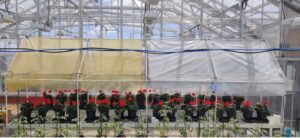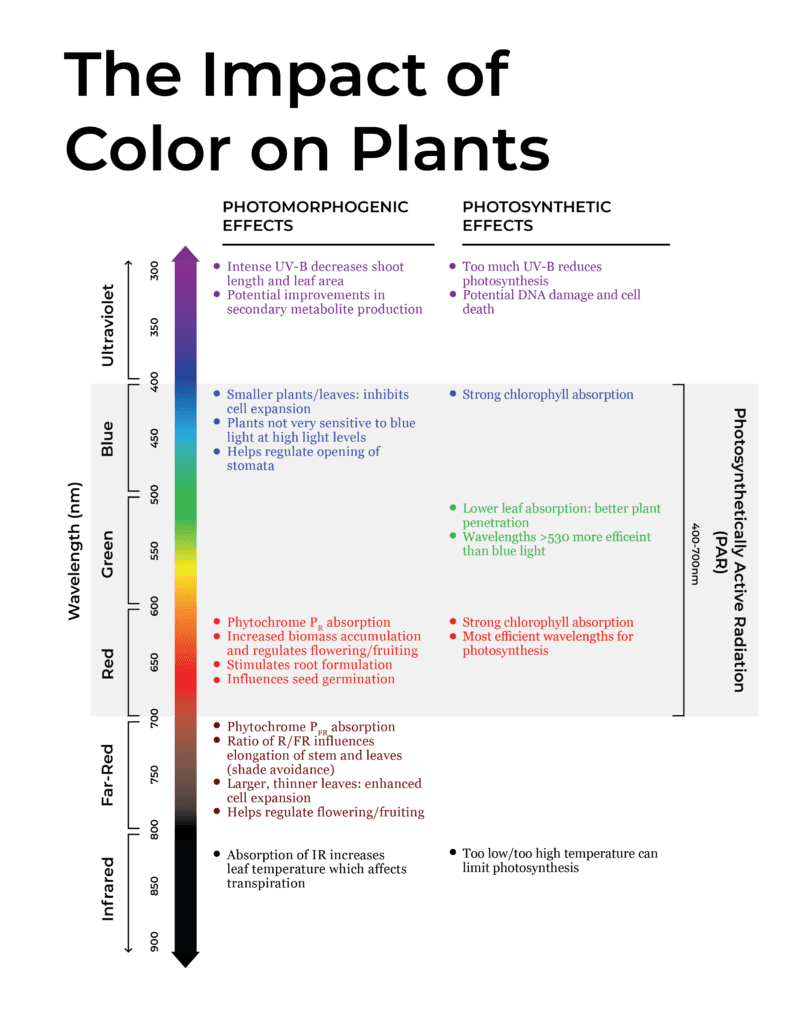
+21% Boost in Flowering in Geranium Trial
+21% Boost in Flowering in Geranium Trial AT A GLANCE</h4 Results Crop Farm Location Results of this study show that plants under the UbiGro film flowered earlier and had more flower clusters when compared to plants under the Control film. 32 Geranium Plants (Pelargonium x hortorum, bedding geraniums) The beautiful geraniums were grown from seed, and then moved to larger pots into the greenhouse where UbiGro was installed. Pebble Labs Research Greenhouse The UbiGro research team performed this experiment in 2019. Pebble Labs Reasearch Greenhouse provided a space for the team to execute their own study of UbiGro. Los Alamos, NM, USA DOWNLOAD CASE STUDY PDF ABOUT THE PROJECT UbiGro (600 nm) quantum dot greenhouse films were installed above a 6 ft x 12 ft (1.8 m x 7.3 m) movable bench inside the Pebble Labs Research Greenhouse (Rough Brothers, ~4,000 ft2, acrylic cover) in Los Alamos, NM, USA. An identical neighboring bench area in the greenhouse was chosen to serve as the Control group, over which a clear polyethylene terephthalate (PET) film was installed to balance the light intensities and diffusivities between the two areas. A Watchdog Plant Growth Micro Station with four quantum (PAR) light sensors was installed to measure daily light integral (DLI) on each side of the experiment using five-minute measurement spacing. On December 15th, 2021, 48 bedding geraniums were grown from seed in a Pro-Mix, perlite, vermiculite and Oscmocote mixed media inside a seed starter dome inside of a greenhouse for 38 days until the seedlings developed two true leaves. The seedlings were then transplanted into 5 inch deep square pots and placed inside the greenhouse under natural lighting conditions, with a temperature ranging from 18°C at night to 23°C during the day, and humidity ranging from 20-45% (average 28%). At 79 Days after sowing (DAS), the plants were transplanted for a second time into larger 2.5 gal (8.7 L) containers and placed under a 16 hour photoperiod using natural and supplemental lighting in the greenhouse. At 91 DAS, the plants were separated into two groups of 16 and placed under UbiGro and Control treatments for the remainder of the experiment. The experiment lasted 136 days from initial seeding to experimental conclusion and ended on April 30th. All crops were grown using an automated drip watering system and fertilized monthly with 1 tsp/plant of Osmocote applied as a topdress to the soil. FLOWERING Once the plants started growing flower buds, flower cluster and flowering data were recorded. A plant was determined to be flowering if it had at least one completely open flower in a flower cluster. First flowering was observed April 4th, 110 DAS. By 131 DAS, all 16 plants on both sides exhibited flowers. The UbiGro side achieved full flowering (all 16 plants) three days sooner than the Control side, as shown in the figure below. Each day, flower clusters were counted on each plant. A flower cluster was defined as a cluster protruding beyond the leaf canopy. There was a larger number of flower clusters under the UbiGro film treatment than the control film treatment, as shown in the figure below. The plants under the UbiGro treatment consistently had more flower clusters compared to plants under the control during the duration of the experiment. By the end of the experiment there were 119 flower clusters on plants under the UbiGro film and 98 flower clusters on those under the Control film, an improvement of 21% in flowering. DLI BALANCE Daily light integral (DLI) data was collected using sensors that were installed at approximately plant height from 121 DAS to the end of the experiment. While this date range does not encompass the entire experiment, this is a representative data set adequate to measure DLI balance. On average, the DLI difference between the two experimental sides was approximately one percent, with slightly more light on the UbiGro side. DLIs averaged 19 mol/m2/day. In this experiment, the effects of the UbiGro luminescent film spectrum on the number of flower clusters and number of flowering plants amongst a group of bedding geraniums were studied by a comparison to plants grown under a Control film. Plants under both treatments started flowering at similar times, with plants under the UbiGro film showing increases in number of flowering clusters and percentage of flowering plants throughout the experiment. In general, plants under the UbiGro film flowered earlier and had more flower clusters when compared to plants under the Control film. These results suggest that the UbiGro luminescent film can promote moderately earlier flowering times and increases the number of flowers of bedding geraniums as compared to a Control group when grown under similar lighting and climate conditions. Acknowledgement* The Daily Light Integral (DLI) is the amount of photosynthetic light received in one square meter each day. The average DLI is a measure of the quantity of light received by a plant over a given duration. Share: DOWNLOAD CASE STUDY PDF Share: Related Posts Social









